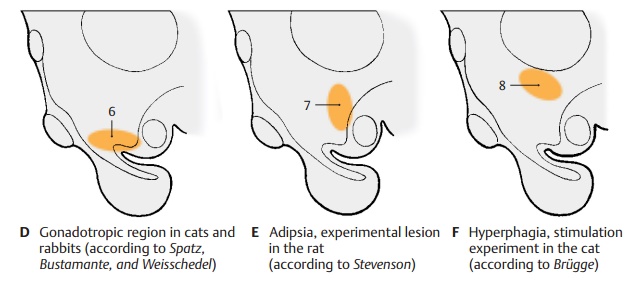Chapter: Human Nervous System and Sensory Organs : Diencephalon
Functional Topography of the Hypothalamus
Functional Topography of the Hypothalamus
The centers of the hypothalamus influence all processes that are important for the in-ternal environment of the body; they regulate the performance of organs according to the actual physical load, that is, they control the balance of temperature, water, and electrolytes; the activity of the heart; circulation and respiration; metabolism; and the rhythm of sleeping and waking.
Vital functions (such as food intake, gastrointestinal activity and defecation, fluid intake and urination) are controlled from here, and so are the processes essential for the preservation of the species (procrea-tion and sexuality). These vital activities are triggered by physical needs that are per-ceived as hunger, thirst, or sexual drive. In-stinctive activities serving the preservation of the organism are usually accompanied by a strong affective component, such as desire or aversion, joy, anxiety, or anger. Hypo-thalamic excitation plays an important role in the creation of these emotions.
Dynamogenic and Trophotropic Zones (A – C)
Electric stimulation of the hypothalamus evokes autonomic reactions that can be divided into two groups (A): those as-sociated with regeneration and metabolic processes (blue symbols: contraction of the pupils; slowing down of respiration; drop in blood pressure ![]() ; urination; defe-cation), and those associated with in-creased performance in response to the en-vironment (red symbols: dilation of the pupils
; urination; defe-cation), and those associated with in-creased performance in response to the en-vironment (red symbols: dilation of the pupils ![]() ; accelerated respiration ; in-crease in blood pressure ). Stimulation re-sponses from specific regions have estab-lished a dorsocaudal and lateral region for the dynamogenic mechanisms, the dynamo-genic zone (B1), and a ventro-oral region forthe mechanisms promoting regeneration, the trophotropic zone (B2). The two regionscorrespond to the subdivision of the periph-eral autonomic nervous system into a sym-pathetic component (dynamogenic) and a parasympathetic component (trophotropic). In humans, controlled stimulation of the caudal hypothalamus (C) yielded sim-ilar results, namely, dilation of pupils (C3), increase in blood pressure (C4), and accel-erated respiration (C5).
; accelerated respiration ; in-crease in blood pressure ). Stimulation re-sponses from specific regions have estab-lished a dorsocaudal and lateral region for the dynamogenic mechanisms, the dynamo-genic zone (B1), and a ventro-oral region forthe mechanisms promoting regeneration, the trophotropic zone (B2). The two regionscorrespond to the subdivision of the periph-eral autonomic nervous system into a sym-pathetic component (dynamogenic) and a parasympathetic component (trophotropic). In humans, controlled stimulation of the caudal hypothalamus (C) yielded sim-ilar results, namely, dilation of pupils (C3), increase in blood pressure (C4), and accel-erated respiration (C5).


Stimulation and Lesion Experiments(D – F)
Experiments of these types reveal the sig-nificance of defined regions for the regula-tion of certain processes; destruction of the tuber cinereum in the region of the infun-dibular nucleus (D6) in juvenile animals leads to atrophy of the gonads. On the other hand, lesions between optic chiasm and tuber cinereum in infantile rats result in premature sexual development. Estrous cycleand sexual behavior are affected by lesions to the hypothalamus. Lesions to the caudal hypothalamus between the tuber cinereum and the premamillary nucleus (E7) lead to adipsia (cessation of spontaneous drinking).More dorsal lesions result in aphagia (re-fusal to eat), while dorsal stimulation (F8) results in hyperphagia (compulsive eating). In the anterior hypothalamus at the level of the optic chiasm lies a region responsible for the control of body temperature. Stimula-tion in the vicinity of the fornix triggers fits of rage and aggressive behavior (perifornicalzone of rage).
Clinical Note: In humans, pathologicalprocesses in the hypothalamus cause similar changes (premature sexual development, bulimia,anorexia nervosa).
A9 Hypophysial stalk.
B10 Hypophysis.
B11 Mamillary body.

Related Topics